2020 Aegean Sea earthquake
The 2020 Aegean Sea earthquake and tsunami, also known as the Samos or İzmir earthquake had a moment magnitude of 7.0 which struck on Friday, 30 October 2020, about 14 km (8.7 mi) northeast of the Greek island of Samos. Many buildings were severely damaged or collapsed as a result of the earthquake, with the Church the Assumption of Mary in Karlovasi, Greece, partially collapsing, while in the Turkish city İzmir, which was heavily affected by the earthquake, dozens of buildings were either damaged or completely collapsed. Emergency services in both countries immediately attended the scene, as rescue efforts continued into the night.
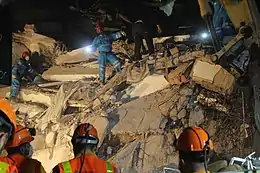 | |
.jpg.webp) Intensity map of the earthquake from the United States Geological Survey | |
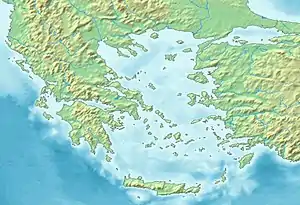 | |
| UTC time | 2020-10-30 11:51:26 |
|---|---|
| ISC event | 619514791 |
| USGS-ANSS | ComCat |
| Local date | 30 October 2020 |
| Local time | 14:51 TRT (UTC+3)[1] |
| Magnitude | 6.9 Mww (Kandilli)[2] 7.0 Mww (USGS)[3] |
| Depth | 11.8 km (Kandilli)[4] 21.0 km (USGS)[3] |
| Epicentre | 37.918°N 26.790°E East Aegean Sea |
| Type | Normal |
| Areas affected | İzmir, Turkey and Samos, Greece |
| Total damage | > $400 million |
| Max. intensity | VIII (Severe) |
| Tsunami | 1.9 meters (Highest: 6 meters) |
| Foreshocks | ML 3.0? |
| Aftershocks | 2,800+, highest so far is a Mw 5.3 |
| Casualties | 119 dead, 1,053 injured, 15,000 homeless[5][6] |
117 people are known to have died in Turkey's İzmir Province, with 1,034 more injured.[7][8] In Greece, there were an additional two fatalities and nineteen minor injuries.[9] The earthquake is the most powerful in the Aegean Sea since 1981, and the deadliest in İzmir Province since a magnitude 6.6 killed four people in 1955.[10][11] The earthquake is also the deadliest in the year of 2020.
Tectonic setting
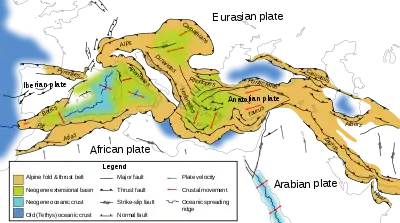
The Aegean Sea is a seismically active region with complex plate tectonics interaction both within and surrounding the Aegean Sea Plate. The region has several major plate boundary including the North Anatolian Fault which runs through northern Turkey, where the Anatolian Plate slides past the Eurasian Plate along this right-lateral strike-slip fault. Another major boundary is the East Anatolian Fault where the Arabian Plate interacts with the Anatolian Plate. This transform fault was responsible for the 2020 Elazığ earthquake.
At its southern edges, the African Plate converges north at 5–10 mm/yr towards the Aegean Sea Plate at a rate of 5–10 mm/yr. It subducts or dives beneath the Aegean, occasionally producing great megathrust earthquakes and tsunamis including the 365 Crete earthquake. However, the subduction rate along the Hellenic subduction zone at 35 mm/yr which greatly exceeds the velocity of the African Plate. For that, north-south extension within Aegean Sea Plate in the back-arc compensate the subduction rate. Shallow crustal earthquakes within the Aegean Sea Plate is a result of this extension, accommodated by east-west trending normal faults.[12]
Earthquake
Following the earthquake, Samos was affected by hundreds of aftershocks.[13] The magnitude of the earthquake was frequently misreported as 6.6 Mww in the Turkish media, due to an erroneous announcement by AFAD.[14][15] The quake was reportedly felt in the Greek island of Crete, the BBC added. While minor shaking was also felt in some regions of Athens.[16]
Geology
The earthquake occurred as a result of pure normal faulting at a shallow crustal depth within the Eurasian Plate in the eastern Aegean Sea, about 250 km north of the closest main plate boundary, where the African Plate moves to the north at a rate of approximately 10 mm per year with respect to the Eurasian.[17] Therefore, this earthquake is considered an intraplate earthquake due to its location.
The Samos Fault is an east-west striking, north dipping normal fault located offshore, north of the coast of Samos. It ruptured for a length of 37 kilometers and had a maximum slip of 1.8 meters during this earthquake, causing uplift on the island of Samos for 18–25 cm.[18][19] The fault has been considered dangerous to populations surrounding the area due to its past history of earthquakes. On August 11 of 1904, Samos was rocked by a magnitude 6.8 earthquake causing substantial damage to Greece and Turkey, killing four.[19] In a 2009 study, the fault had the potential to produce an earthquake of magnitude 6.8.[20][21]
Aftershocks
As of November 8, over 2,800 aftershocks have been recorded.[22] The mainshock may have been preceded by a foreshock on the 5th of May the same year.[23]
| Date and time (UTC) | Location | M | MMI | Ref |
|---|---|---|---|---|
| 30 October, 12:19:09 | 5 km NW of Marathókampos, Greece | 4.4 | - | [24] |
| 30 October, 12:41:31 | 4 km N of Samos, Greece | 4.0 | V | [25] |
| 30 October, 13:00:43 | 8 km N of Kokkári, Greece | 4.9 | - | [26] |
| 30 October, 15:14:55 | 8 km NW of Kokkári, Greece | 5.3 | VI | [27] |
| 30 October, 15:19:15 | 2 km SW of Samos, Greece | 4.8 | - | [28] |
| 30 October, 17:16:03 | 7 km NE of Samos, Greece | 4.2 | - | [29] |
| 30 October, 19:09:40 | 17 km NE of Agios Kirykos, Greece | 4.2 | - | [30] |
| 30 October, 22:53:22 | 9 km NNE of Néon Karlovásion, Greece | 4.1 | - | [31] |
| 31 October, 01:40:33 | 19 km WNW of Néon Karlovásion, Greece | 4.2 | - | [32] |
| 31 October, 05:31:30 | 10 km NNW of Kokkári, Greece | 4.9 | III | [33] |
| 31 October, 12:36:20 | 5 km W of Kokkári, Greece | 4.2 | - | [34] |
| 31 October, 14:42:43 | 26 km WNW of Néon Karlovásion, Greece | 4.3 | III | [35] |
| 31 October, 22:05:43 | 4 km NNE of Kokkári, Greece | 4.0 | - | [36] |
| 1 November, 07:05:13 | 9 km NNE of Samos, Greece | 4.2 | - | [37] |
| 1 November, 07:33:08 | 1 km NNE of Kokkári, Greece | 4.2 | - | [38] |
| 1 November, 12:57:03 | 2 km NNW of Kokkári, Greece | 4.4 | - | [39] |
| 2 November, 11:58:03 | 5 km NNE of Kokkári, Greece | 4.3 | III | [40] |
| 2 November, 12:30:39 | 20 km SSW of Seferihisar, Turkey | 4.4 | II | [41] |
| 2 November, 19:16:40 | 19 km WNW of Néon Karlovásion, Greece | 4.5 | - | [42] |
| 3 November, 20:35:35 | 22 km WNW of Néon Karlovásion, Greece | 4.0 | - | [43] |
| 4 November, 13:21:31 | 6 km ENE of Megálo Chorió, Greece | 4.2 | - | [44] |
| 9 November, 20:31:00 | 12 km NNE of Kokkári, Greece | 4.3 | II | [45] |
| 11 November, 06:49:45 | 9 km NE of Kokkári, Greece | 4.6 | IV | [46] |
| 12 November, 03:34:15 | 9 km WSW of Kokkári, Greece | 4.4 | - | [47] |
| 4 December, 09:34:16 | 7 km ENE of Néon Karlovásion, Greece | 4.5 | - | [48] |
| 30 December, 13:40:13 | 7 km ENE of Agios Kirykos, Greece | 4.1 | III | [49] |
| 20 January, 23:37:57 | 10 km NNE of Néon Karlovásion, Greece | 4.6 | IV | [50] |
Tsunami
Tsunami information was issued by the Kandilli Observatory Earthquake Monitoring and Tsunami Warning Center to the Earthquake Research Department of Turkey 11 minutes after the earthquake but was not broadcast to the coastal regions. The tsunami arrived between 10 and 15 minutes after the mainshock.[21]
Multiple social media posts showed water rushing through streets and ports in the region following the earthquake, along with tsunami warnings being issued for the islands of Ikaria, Kos, Chios and Samos.[51] Seferihisar was among the places hit by the tsunami, causing a fatality.[52][53] Flooding from the coasts reached heights of 1.9 meters (6 feet), however at Akarca, the tsunami reached heights of 6 meters (19 feet).[54] In Azmak, the tsunami penetrated 1.3 kilometers (0.8 miles) inland, 0.82 kilometers (0.5 miles) in Akarca, and 0.32 kilometers (0.2 miles) in Sigacik. Recorded heights of the tsunami from this event were larger that of other similar magnitude quakes in the same region with the exception of the 1956 Amorgos earthquake.[54]
Damage
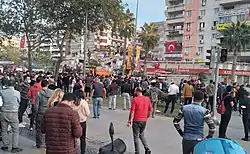
Initially, Turkish Minister of the Interior Süleyman Soylu stated that at least six buildings were destroyed in İzmir, but the city's mayor Tunç Soyer later put the number of collapsed buildings closer to 20.[51]
Greek authorities from Samos stated that although buildings were damaged across the island, the worst sustained was in Karlovasi,[55] where a large church had partially collapsed. In Karlovasi, over 100 buildings were damaged upon inspection.[56] It is the first time since the 2017 Aegean Sea earthquake that there are earthquake-related deaths in Greece.[57]
Many buildings collapsed in İzmir's Bayraklı and Bornova districts.[58] Most of the buildings which collapsed were built in the 1990s, based on outdated earthquake regulations from 1975. Poor construction practices and code compliance were reasons for the collapse.[59] Additionally, the first floors of these buildings were altered for commercial use such as shops. Taller buildings with heights of 100 to 240 meters, however, did not sustain structural damages. The city is also built on soft sediments in a basin which amplified the intensity of shaking despite its distance from the epicenter.[60]
On 4 November, mayor of İzmir Tunç Soyer stated that 15,000 people lost their homes only in İzmir in the earthquake.[61]
Total damage is estimated to be in the millions for Greece, and over $400 million for Turkey.[62]
Casualties
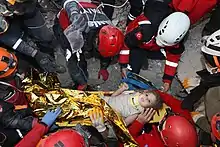
117 people died and 1,034 more were injured in Turkey, all but one from the city of Izmir,[7] while two teenagers died in Greece after being crushed by a wall on the island of Samos; 19 others were injured in Greece.[6] The other Turkish victim outside Izmir died from drowning in the advancing tsunami in the district of Seferihisar.
Relief operations
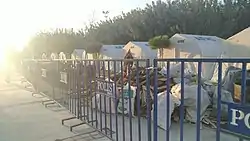
Right after the earthquake, Turkish Minister of Health Fahrettin Koca stated that about 40 ambulances, 35 emergency rescue teams and two ambulance helicopters had reached the scene,[63] while Turkey's Ministry of National Defence stated that one of its planes had departed from Etimesgut Air Base to transport AFAD and gendarmerie teams to the region.[64] The Turkish Red Crescent immediately deployed teams from six cities to provide food to those affected by the earthquake.[65] More than 1,200 workers were involved in rescue efforts involving at least 13 buildings in İzmir,[51] which continued into the night. According to Al Jazeera, the personnel involved in the rescue operations had reached about 8,000, including 25 rescue dogs.[66][67] Turkish authorities stated that 106 people were rescued, while the local government had set up tents to house about 2,000 people overnight. A three-year-old Ayda Gezgin was also said to have been the second little girl rescued on Tuesday, from an 8-story building.[6][68] A total of 17 collapsed buildings were part of the search and rescue operations, according Mehmet Gulluoglu, head of Turkey’s Disaster and Emergency Management Presidency.[69]
International reactions
Countries:
 United States
United States
- The US embassy has shared their condolences for the dead and wounded in the earthquake.[70]
- The NASA analyzed satellite imagery and worked with the Turkish Space Agency and several universities in the affected region. [71]
 Germany - The German embassy in Ankara has shared the following message from Twitter "After the earthquake in Izmir, our thoughts are with the victims and their relatives. Get well soon, Izmir!".
Germany - The German embassy in Ankara has shared the following message from Twitter "After the earthquake in Izmir, our thoughts are with the victims and their relatives. Get well soon, Izmir!".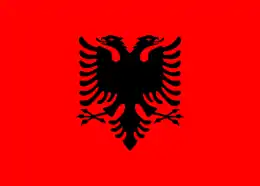 Albania - The Albanian ambassador Kastriot Robo said "Where are with our friends in this hard time".[72]
Albania - The Albanian ambassador Kastriot Robo said "Where are with our friends in this hard time".[72].svg.png.webp) Australia - The Australian ambassador to Turkey Marc Innes-Brown shared his condolences and said the following "After the earthquake in Izmir, our thoughts are with the victims and their relatives. Get well soon, Izmir!".
Australia - The Australian ambassador to Turkey Marc Innes-Brown shared his condolences and said the following "After the earthquake in Izmir, our thoughts are with the victims and their relatives. Get well soon, Izmir!".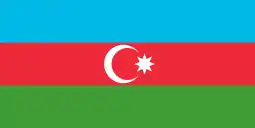 Azerbaijan
Azerbaijan
- The Azerbaijani President İlham Aliyev called the Turkish President Recep Tayyip Erdoğan. He said that he was sorry and they were prepared to offer aid.[72]
- The President of the National Parliament of Azerbaijan Sahibe Gafarova shared his condolences with his counterpart Mustafa Sentop.[72]
 United Kingdom - The ambassador of UK Dominick Chilcott shared his condolences and said the following "The United Kingdom as always, will be in the side with Turkey".[72]
United Kingdom - The ambassador of UK Dominick Chilcott shared his condolences and said the following "The United Kingdom as always, will be in the side with Turkey".[72] Denmark - The Danish ambassador Danny Annan, shared his condolences and said the following "I wish my condolences to the relatives of those who lost their lives and a speedy recovery for their benefits.".
Denmark - The Danish ambassador Danny Annan, shared his condolences and said the following "I wish my condolences to the relatives of those who lost their lives and a speedy recovery for their benefits.". France - French Minister of İnternal Affairs Gérald Darmanin, has said that France was ready to offer support to Greece and Turkey.[73]
France - French Minister of İnternal Affairs Gérald Darmanin, has said that France was ready to offer support to Greece and Turkey.[73]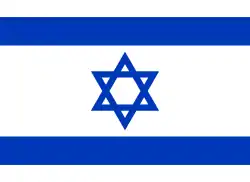 Israel - Israeli Minister of Defense Benny Gantz said that they were ready to assist Turkey by sending a search and rescue team and a field hospital.[72]
Israel - Israeli Minister of Defense Benny Gantz said that they were ready to assist Turkey by sending a search and rescue team and a field hospital.[72] Qatar
Qatar
- Embassy of Qatar said the following "Due to the Earthquake that happened in Izmir we share our condolences with the Turkish Government and to our Turkish brothers".
- A Disaster Information Management Centre was set up in Izmir by the Qatar Red Crescent Society.[74]
 Kazakhstan
Kazakhstan
- The President of the Kazak Parliament Nurlan Nigmatulin, "Stating that we stand by the brotherly Turkish people and share their grief in this tragic moment, I express my urgent healing wishes to the wounded. I wish you patience and fortitude of the people of Turkey.".[75]
- Kazakh Minister of Foreign Affairs Mukhtar Tleuberdi, sent the following message to his counterpart Mevlüt Çavuşoğlu, "I offer my deepest condolences to the bereaved families who lost their relatives by sharing irreplaceable grief. May Allah treat the deceased with His mercy. I wish urgent healing to the injured. We always pray for the well-being of the brotherly Turkish people.".
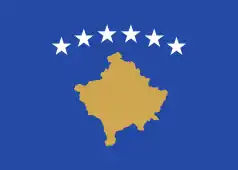 Kosovo - Kosovo President Hashim Thaçi, shared his condolences and said the following from social media, "Our prayers are with the relatives of those who lost their lives and the injured, Kosovo stands by the Turkish people and state in this difficult time.".[72]
Kosovo - Kosovo President Hashim Thaçi, shared his condolences and said the following from social media, "Our prayers are with the relatives of those who lost their lives and the injured, Kosovo stands by the Turkish people and state in this difficult time.".[72]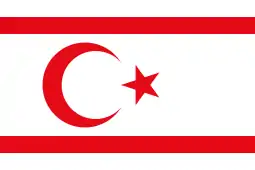 Northern Cyprus - The President of TRNC Ersin Tatar has called the Turkish President Recep Tayyip Erdoğan and shared his condolences.
Northern Cyprus - The President of TRNC Ersin Tatar has called the Turkish President Recep Tayyip Erdoğan and shared his condolences. Hungary - The Hungarian ambassador Viktor Matis shared his condolences.[76]
Hungary - The Hungarian ambassador Viktor Matis shared his condolences.[76]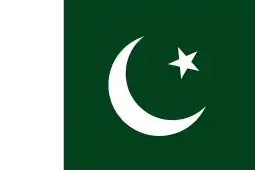 Pakistan - The Pakistani Ministry of Foreign Affairs said the following, "We are always with our Turkish brothers and our prayers are with you".[77]
Pakistan - The Pakistani Ministry of Foreign Affairs said the following, "We are always with our Turkish brothers and our prayers are with you".[77] Russia
Russia
- Russian President Vladimir Putin shared his condolences with the Turkish President Recep Tayyip Erdoğan.[78]
- The Russian embassy said the following "Izmir Seferihisar earthquake in Turkey thus extend our best wishes and we hope there will be no loss of life.".
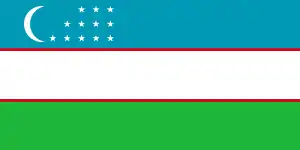 Uzbekistan - The Uzbekistani President Şevket Mirziyoyev shared his condolences.[72]
Uzbekistan - The Uzbekistani President Şevket Mirziyoyev shared his condolences.[72]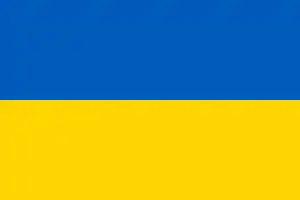 Ukraine - The Ukrainian President Volodymyr Zelensky expressed his condolences on Twitter.[79]
Ukraine - The Ukrainian President Volodymyr Zelensky expressed his condolences on Twitter.[79]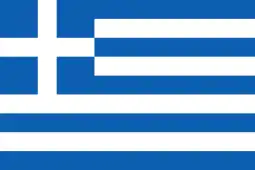 Greece - The Greek Minister of Foreign Affairs Nikos Dendias has called his counterpart Mevlüt Çavuşoğlu and shared his condolences.[80][72]
Greece - The Greek Minister of Foreign Affairs Nikos Dendias has called his counterpart Mevlüt Çavuşoğlu and shared his condolences.[80][72] Japan - The Japanese Prime Minister Suga Yoshihide shared his condolences and said the following, "We are deeply saddened by the news that many people have died and there is serious damage, Like Turkey, Japan has experienced serious damage from earthquakes many times, and Japan and Turkey have supported each other during past earthquakes. Japan will always be with the people of Turkey in overcoming these hardships.".[81]
Japan - The Japanese Prime Minister Suga Yoshihide shared his condolences and said the following, "We are deeply saddened by the news that many people have died and there is serious damage, Like Turkey, Japan has experienced serious damage from earthquakes many times, and Japan and Turkey have supported each other during past earthquakes. Japan will always be with the people of Turkey in overcoming these hardships.".[81]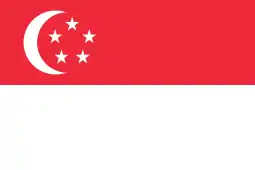 Singapore - The Minister for Foreign Affairs Vivian Balakrishnan offered his condolences to both countries, adding that the country is ready to offer assistance.[82]
Singapore - The Minister for Foreign Affairs Vivian Balakrishnan offered his condolences to both countries, adding that the country is ready to offer assistance.[82]
International organizations:
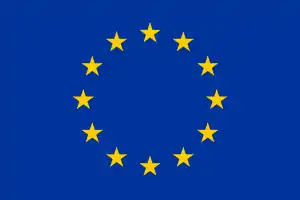 European Union
European Union
- EU Council President Charles Michel: "Developments related Strong earthquake off the coast of the Aegean Sea in Greece and Turkey are closely monitored.".[83]
- The EU Turkey Delegation President and Ambassador Nikolaus Meyer-Landrut heard deep sorrow for the earthquake victims "The EU expresses its deepest condolences to the families of the earthquake victims, would wish healing for a moment before the injured.".[83]
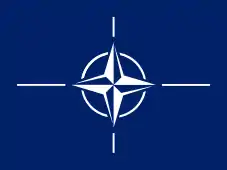 NATO - NATO General Secretary Jens Stoltenberg said they were ready to offer assistance.
NATO - NATO General Secretary Jens Stoltenberg said they were ready to offer assistance. Turkic Council - Turkic Council General Secretary Bağdad Andreyev shared his condolences.[84]
Turkic Council - Turkic Council General Secretary Bağdad Andreyev shared his condolences.[84]
See also
- 2020s in environmental history
- 1904 Samos earthquake
- 2017 Aegean Sea earthquake
- List of earthquakes in 2020
- 1985 Mexico City earthquake - basin soil amplified shaking which caused destruction to the city's infrastructures
References
- "Twenty one dead, more than 700 wounded in earthquake in Turkey's Izmir". Ahval. 30 October 2020. Retrieved 30 October 2020.
- "30 Ekim 2020 Ege Denizi Depremi" [30 October 2020 Aegean Sea Earthquake] (PDF). Kandilli Observatory. 30 October 2020. Archived from the original (PDF) on 1 November 2020. Retrieved 1 November 2020.
- "M 7.0 – 15 km NNE of Néon Karlovásion, Greece". USGS. Archived from the original on 30 October 2020. Retrieved 30 October 2020.
- www.koeri.boun.edu.tr, accessed 6 November 2020
- "Three-year-old girl rescued 91 hours after Turkey quake". Al Jazeera.
- "Earthquake hits Greece and Turkey, bringing deaths and floods". BBC News. 30 October 2020. Retrieved 30 October 2020.
- Özmen, Merve Yıldızalp (14 November 2020). "İzmir'deki depremde can kaybı 116'ya yükseldi". Anadolu Agency.
- admin (8 November 2020). "Turkey's earthquake death toll rises to 115". Time24 Story. Retrieved 9 November 2020.
- RTnews (31 October 2020). "Turkey's Erdogan & Greek PM Mitsotakis exchange words of SUPPORT after deadly Aegean Sea quake hits both nations". EMEA Tribune. Retrieved 5 November 2020.
- "M 7.2 - Aegean Sea". USGS-ANSS.
- "M 6.6 - western Turkey". USGS-ANSS.
- Kiratzi, Anastasia A. (2014). "Mechanisms of Earthquakes in Aegean". Department of Geophysics. Encyclopedia of Earthquake Engineering. Aristotle University of Thessaloniki, Greece.
- Sariyuce, Isil; Salem, Mostafa; Dewan, Angela (30 October 2020). "Powerful earthquake jolts Turkey and Greece, killing at least 14". CNN. Retrieved 30 October 2020.
- "Celal Şengör isyan etti: Lütfen şu 6,6'yı artık silin". cumhuriyet.com.tr (in Turkish). Cumhuriyet. 2 November 2020. Retrieved 2 November 2020.
- "Son dakika... İzmir'de 6.9 büyüklüğünde deprem! İstanbul'da da hissedildi!" [Last minute... 6.9 magnitude earthquake in Izmir! It was felt in Istanbul too!]. sozcu.com.tr (in Turkish). Sözcü. 31 October 2020. Retrieved 2 November 2020.
- "Earthquake hits Greece and Turkey, bringing deaths and floods".
- "M 7.0 – 14 km NE of Néon Karlovásion, Greece". Earthquake. Retrieved 30 October 2020.
- Ganas, Athanassios; Elias, Panagiotis; Briole, Pierre; Tsironi, Varvara; Valkaniotis, Sotiris; Escartin, Javier; Karasante, Ilektra; Efstathiou, Eirini (5 November 2020). "Fault responsible for Samos earthquake identified". Temblor.
- Eyidoğan, Haluk (2020). "Report on the seismological characteristics and effects of the 30 October 2020 Samos-Kuşadası Bay earthquake (Mw7.0) in the western Aegean Sea" (PDF). Cite journal requires
|journal=(help) - Spyros PAVLIDES, Theodoros TSAPANOS, Nikos ZOUROS, Sotiris SBORAS, George KORAVOS and Alexandros CHATZIPETROS (2009). "Using active fault data for assessing seismic hazard: a case study from NE Aegean sea, Greece". Proceedings of the XVII International Conference on Soil Mechanics & Geotechnical Engineering, Earthquake Geotechnical Engineering Satellite Conference.CS1 maint: multiple names: authors list (link)
- P. Papadimitriou, V. Kapetanidis, A. Karakonstantis, I. Spingos, I. Kassaras, V. Sakkas, V. Kouskouna, A. Karatzetzou, K. Pavlou, G. Kaviris, N. Voulgaris (2020). "Preliminary report on the Mw=6.9 Samos earthquake of 30 October 2020" (PDF). Retrieved 26 December 2020.CS1 maint: multiple names: authors list (link)
- "İzmir Seferihisar Depremi-Duyuru 73 (08.11.2020 - 20.00)". AFAD.
- "M 3.0 - 10 km WSW of Kuşadası, Turkey".
- "M 4.4 - 5 km NW of Marathókampos, Greece". USGS-ANSS. Retrieved 26 December 2020.
- "M 4.0 - 4 km N of Samos, Greece". USGS-ANSS. Retrieved 26 December 2020.
- "M 4.9 - 8 km N of Kokkári, Greece". USGS-ANSS. Retrieved 26 December 2020.
- "M 5.3 - 8 km NW of Kokkári, Greece". USGS-ANSS. Retrieved 26 December 2020.
- "M 4.8 - 2 km SW of Samos, Greece". USGS-ANSS. Retrieved 26 December 2020.
- "M 4.2 - 7 km NE of Samos, Greece". USGS-ANSS. Retrieved 26 December 2020.
- "M 4.2 - 17 km NE of Agios Kirykos, Greece". USGS-ANSS. Retrieved 26 December 2020.
- "M 4.1 - 9 km NNE of Néon Karlovásion, Greece". USGS-ANSS. Retrieved 26 December 2020.
- "M 4.2 - 19 km WNW of Néon Karlovásion, Greece". USGS-ANSS. Retrieved 26 December 2020.
- "M 4.9 - 10 km NNW of Kokkári, Greece". USGS-ANSS. Retrieved 26 December 2020.
- "M 4.2 - 5 km W of Kokkári, Greece". USGS-ANSS. Retrieved 26 December 2020.
- "M 4.3 - 26 km WNW of Néon Karlovásion, Greece". USGS-ANSS. Retrieved 26 December 2020.
- "M 4.0 - 4 km NNE of Kokkári, Greece". USGS-ANSS. Retrieved 26 December 2020.
- "M 4.2 - 9 km NNE of Samos, Greece". USGS-ANSS. Retrieved 26 December 2020.
- "M 4.2 - 1 km NNE of Kokkári, Greece". USGS-ANSS. Retrieved 26 December 2020.
- "M 4.4 - 2 km NNW of Kokkári, Greece". USGS-ANSS. Retrieved 26 December 2020.
- "M 4.3 - 5 km NNE of Kokkári, Greece". USGS-ANSS. Retrieved 26 December 2020.
- "M 4.4 - 20 km SSW of Seferihisar, Turkey". USGS-ANSS. Retrieved 26 December 2020.
- "M 4.5 - 19 km WNW of Néon Karlovásion, Greece". USGS-ANSS. Retrieved 26 December 2020.
- "M 4.0 - 22 km WNW of Néon Karlovásion, Greece". USGS-ANSS. Retrieved 26 December 2020.
- "M 4.2 - 6 km ENE of Megálo Chorió, Greece". USGS-ANSS. Retrieved 26 December 2020.
- "M 4.3 - 12 km NNE of Kokkári, Greece". USGS-ANSS. Retrieved 26 December 2020.
- "M 4.6 - 9 km NE of Kokkári, Greece". USGS-ANSS. Retrieved 26 December 2020.
- "M 4.4 - 9 km WSW of Kokkári, Greece". USGS-ANSS. Retrieved 26 December 2020.
- "M 4.5 - 7 km ENE of Néon Karlovásion, Greece". USGS-ANSS. Retrieved 26 December 2020.
- "M 4.1 - 7 km ENE of Agios Kirykos, Greece". USGS-ANSS. Retrieved 31 December 2020.
- "M 4.6 - 10 km NNE of Néon Karlovásion, Greece". USGS-ANSS. Retrieved 21 December 2020.
- Specia, Megan; Stevis-Gridneff, Matina (30 October 2020). "Earthquake Rattles Western Turkey and Greece, Leveling Buildings". The New York Times. ISSN 0362-4331. Retrieved 30 October 2020.
- "Seferihisar'da tsunami: Sokakları deniz suyu bastı" [Tsunami in Seferihisar: Sea water flooded the streets]. NTV. 30 October 2020. Retrieved 30 October 2020.
- "Son dakika! İzmir'de tsunami paniği" [Last minute! Tsunami panic in Izmir]. Milliyet. 30 October 2020. Retrieved 30 October 2020.
- Dağ, Burak (4 November 2020). "Turkey sees larger tsunami after latest quake". Anadolu Agency. Retrieved 9 November 2020.
- Liakos, Chris; Labropoulou, Elinda (30 October 2020). "Minor injuries and building damage reported on Greek island". CNN. Retrieved 30 October 2020.
- Newsroom (31 October 2020). "Samos Earthquake: Over 200 autopsies - Damage to about 100 buildings in Karlovasi". CNN Greece. Retrieved 26 December 2020.
- Labropoulou, Elinda (30 October 2020). "Buildings damaged on Greek island of Samos". CNN. Retrieved 30 October 2020.
- "Son dakika: Türkiye'nin gözü kulağı deprem bölgesinde... İşte İzmir depremiyle ilgili dakika dakika son gelişmeler" [Last minute: the earthquake in Turkey's eyes and ears ... Here are the latest developments related to the earthquake in Izmir minute by minute]. hurriyet.com.tr (in Turkish). Hürriyet. Retrieved 30 October 2020.
- "Destroyed buildings in İzmir not earthquake resistant, reports show". Hürriyet Daily News. 1 November 2020. Retrieved 20 November 2020.
- Erdik, Demircioğlu, Tüzün, Mustafa, Mine B., Cüneyt (14 November 2020). "Forensic analysis reveals the causes of building damage in İzmir in the Oct. 30 Aegean Sea earthquake". Retrieved 20 November 2020.CS1 maint: multiple names: authors list (link)
- "İzmir Büyükşehir Belediye Başkanı Tunç Soyer depremde kaç kişinin evsiz kaldığını açıkladı". Yeni Çağ Gazetesi (in Turkish). 4 November 2020. Retrieved 29 November 2020.
- "Global Catastrophe Recap November 2020" (PDF). Aon. December 10, 2020. Retrieved December 18, 2020.
- Akyavas, Aziz; Smith, Saphora; Mulligan, Matthew (30 October 2020). "Strong quake hits coastal Turkey and Greece, killing at least 6 and injuring over 200". Reuters. Retrieved 30 October 2020 – via Yahoo News.
- "TSK'ye ait uçak AFAD ve jandarma ekiplerini bölgeye ulaştırmak için hareket etti" [The plane belonging to the TAF moved to bring AFAD and gendarmerie teams to the region]. CNN Türk (in Turkish). 30 October 2020. Retrieved 30 October 2020.
- "Turkish Red Crescent mobilizes food assistance teams". CNN (in Turkish). 30 October 2020. Retrieved 30 October 2020.
- "Powerful Quake in Aegean Sea Leaves 6 Dead; Buildings Toppled in Turkey, Greece". Voice of America. 30 October 2020. Retrieved 30 October 2020.
- "Three-year-old girl rescued 91 hours after Turkey quake".
- "2nd little girl pulled alive from Turkey's earthquake devastation".
- "Turkey quake toll rises to 116 as rescuers conclude searches". Al Jazeera. 4 November 2020.
- SABAH, DAILY (30 October 2020). "Turkey, Greece pledge mutual aid, support after strong quake shakes Aegean". Daily Sabah. Retrieved 13 January 2021.
- "Aegean Sea Earthquake October 2020 | NASA Applied Sciences". appliedsciences.nasa.gov. Retrieved 13 January 2021.
- Hamit, Dilara (30 October 2020). "Condolences pour in after quake shakes Turkey". Anadolu Agency. Retrieved 25 December 2020.
- AFP (30 October 2020). "France ready to help Turkey, Greece after earthquake". Deccan Herald. Retrieved 25 December 2020.
- Qarjouli, Asmahan (3 November 2020). "Qatar mobilizes disaster management center in Izmir earthquake response". Doha News. Retrieved 28 December 2020.
- SATUBALDINA, ASSEL (3 November 2020). "President Tokayev Sends Condolences to Turkey Over Izmir Earthquake". The Astana Times. Retrieved 25 December 2020.
- Emre Aytekin, Mehmet Yilmaz and Omer Erdem (2 November 2020). "Countries grieve with Turkey after deadly quake". Anadolu Agency. Retrieved 28 December 2020.
- Latif, Aamir (31 October 2020). "Pakistan stands with quake-hit Turkey". Anadolu Agency. Retrieved 25 December 2020.
- DAILY SABAH (30 October 2020). "Russia's Putin conveys condolences to Erdoğan over earthquake in Turkey's Izmir". Daily Sabah. Retrieved 4 December 2020.
- Interfax-Ukraine (1 November 2020). "Zelensky condolences to Turkey, Greece over earthquake". Kyiv Post. Retrieved 25 December 2020.
- "Athens offers to assist rescue efforts in Izmir". Kathimerini. 30 October 2020. Retrieved 4 December 2020.
- Mainichi Japan (2 November 2020). "Japan offers condolences to Turkey over deadly quake". The Mainichi. Retrieved 4 December 2020.
- "Singapore extends condolences to Turkey and Greece after Aegean Sea earthquake". Channel News Asia. 1 November 2020. Retrieved 25 December 2020.
- DAILY SABAH (30 October 2020). "Turkey, Greece pledge mutual aid, support after strong quake shakes Aegean". Daily Sabah. Retrieved 4 December 2020.
- Turan, Rabia Iclal (30 October 2020). "EU, NATO condole with quake-hit Turkey, Greece". Anadolu Agency. Retrieved 25 December 2020.
External links
| Wikimedia Commons has media related to 2020 Aegean Sea earthquake. |